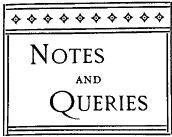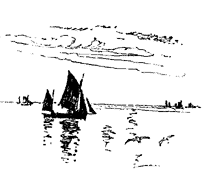[From Manx Note Book vol 2,
1886]
 TREENS
AND QUARTERLANDS. -Were the Treens
or the Quarterlands the older divisions? I used to consider the
Treens the earlier,but as a number of these have names that are
distinctly Norse, e.g. "Sertfield," "Sleckby," "Sulby,"
&c., it would seem otherwise, unless indeed the older names were
lost, and had others substituted for them during the Norwegian
period. K.
TREENS
AND QUARTERLANDS. -Were the Treens
or the Quarterlands the older divisions? I used to consider the
Treens the earlier,but as a number of these have names that are
distinctly Norse, e.g. "Sertfield," "Sleckby," "Sulby,"
&c., it would seem otherwise, unless indeed the older names were
lost, and had others substituted for them during the Norwegian
period. K.
NICKEL MEDAL, (V01. I, P. 36.)-I have a nickel
medal, evidently of the same kind as that previously referred to in THE MANX
NOTE BOOK. On the obverse it bears the " trie cassyn " encircled by the motto
"We stand firm to each other." On the reverse, in the centre is inscribed, "Sir
R. Black, L. Privy Seal to the Knights
of Laxey, Augt 14, 1749," surrounded by "In Love and Friendship." It appears
probable that these medals were struck for some social club that existed in
Laxey, all record of which has passed away, as the query propounded in your
first number has not yet received an answer. J. H. C.
GENERAL CUSTINE,
(VOI. I., P. 73.)-Touching your
note in No. 2, as to Train's allusion to Castine, though I never
could find, in any book, any support for the claim that Custine was a
native of the Isle of Mann. yet an old Kirk Lonan woman, who died
here many years ago, who was illiterate, spoke only Manx, and who
knew the local traditions, was quite familiar with the fact that
there was a "General Costain," who was a Kirk Lonan man, that he was
of Ballaneale, and that he was married to a woman named "Quilleash. "
She spoke of it as a thing well understood and undoubted in her
youth, and she would be most unlikely to have derived her information
from books.
W. S. KERRUISH, Cleveland, Ohio, U.S.A.
FLINTS AT PORT ST. MARY.-In "THE
NOTE BOOK," of July last, I described a find of flints at Port St.
Mary. I now purpose giving a more detailed description of the principal flakes
and implements. A few months ago, I paid two short visits to the locality, and
found it just as I left it in 1882. In these two last visits alone, I succeeded
in unearthing 800 small flakes, splinters, and fragments, as well as 19 nuclei,
or flint cores, 14 large rudely worked flints of uncertain charader, several
sorts of flint scrapers, and other implements. From their abundance I am inclined
to believe that they mark the site of an ancient settlement, and the presence
of shells (mostly limpets) and animals points to the same conclusion. Mr. John
Evans, F.R.S., says-"Flakes and "splinters of flints frequently occur in and
around ancient "encampments and settlements,. "* Being desirous of learning
the true nature of these flints, I sent the principal ones to Professor Boyd
Dawkins, F.R.S. He very kindly examined and noted the most curious among
them, and also gave me his opinion as to their relative age. The following is
what Professor Dawkins says-', The refuse heap and flakes at Port St. Mary may
be of almost any age Neolithic, Bronze, or even Prehistoric, or Historic Iron."
It is impossible to fix it without further evidence than that of the flirits
themselves. They are, however, probably of Neolithic or Bronze age." I am unfortunately
unable to spare time or money in properly excavating the few feet of ground
in which the flints occur; otherwise it should be done at once. I think, however,
that it is the duty of our local Antiquarian Society to make further exhaustive
investigation to ascertain, if possible, the exad relative age of this ancient
refuse heap,-as well as to secure to our future museum, any relics that may
yet remain. Doubtless, if a little energy we e to be shewn in this matter '
and research carried out on some systematic plan, remains of a more important
character than have yet come to light, might be found. In all my own "rooting"
(mostly done with a large nail!) I have not disturbed more than four square
feet of earth, but even in that small space, I have been rewarded by finding
several thousands of flint flakes, and implements. I would venture to suggest
if any further investigations are initiated, that special attention be directed
to the presence among the flints of other relics-such as shells, animal remains,
pottery, or, possibly, ornaments. I have found many pieces of quartz along with
the flints-one of which appears to have been fashioned, but it is so rude that
further evidence is necessary on this point. In conclusion, I would indicate
that the flints are all of the flake type, i.e., that although many of them
bear unmistakeable signs of having been worn by use, few exhibit any marks of
secondary chipping, and even in the latter case to no great extent. In my former
communication I stated that the flints from Port St. Mary were evidently far
more ancient than the Neolithic arrow-head, which I found in oneof the Mull
Hills. I was led to believe so by the fact that Professor Worsaae classes the
Danish "Kjolskenmoddings " between the Drift and Neolithic ages. It is interesting
to find that the same thing occurs in the Isle of Mann as in Denmark, i.e.,
the presence on the coast of rudely worked flakes in large numbers, while in
the tumuli implements are found of a much more perfect character. Sir John Lubbock+
considers that the Danish shellmounds belong to the early Neolithic age, and
the same may be so in regard to the refuse at Port St. Mary. Something might
be done in the Isle of Mann to furnish additional data on this question. Our
Island is very well adapted for this study, as tumuli abound, and I have no
doubt that if searched for in likely places, many more coast finds would be
discovered.
FREDERICK SWINNERTON.
"Ancient Stone Implements of Great Britain," P. 257.
+ "Prehistoric Times," 4th Ed., P. 248.
[see also booklet
by F.S.]
THE THREE LEGS SYMBOL.-At a meeting
of the Cambridge Antiquarian Society held on the 8th of February,
their President, the Rev. G. F. Browne, B.D., in the course of a
communication upon , Some Early Sculptured Stones and Symbols in
Ledsham Church, Yorkshire, "remarked that on a stone in the apsidal
wall, at the point where it leaves the wall of the nave, is an almost
perished incised symbol, which had escaped the keen eyes of the
restorers, formed of a capital S three times. repeated, the head of
each hooking into the tail of another, forming a sort of triangle,
with curved sides of 4 inches. It is startling and suggestive to find
this symbol, cognate with the three
legs of Mann and of Greek shields, and found in Hibernian and
"Pictish " work, in a Yorkshire Church on the borders of the ancient
kingdom of Elmete.
THE GEOGRAPHICAL POSITION OF THE ISLE OF MANN
ACCORDING TO PTOLEMY.-WE extract the following from an
able pamphlet on Ptolerny's Geography of the British Isles, written
by Mr. Henry Bradley, and recently published by the Society of
Antiquaries:-"He places on the sixty-second parallel Ebuda, another
Ebuda, and Ricina; and a little further north is Maleus. These five
islands are collectively called by him the Ebudae. A little south of
these is Monaceda. The two Ebudae proper may be identified with Islay
and Jura, the close mutual proximity of which may account for their
being bracketed together under a common name. Ricina, from its name
and its position near to Fair Head seems to be Rathlin (Irish Rechra,
genitive Rechrann.) Malcus-the position and the name again concurring
appear to be Mull. There is some uncertainty as to the reading of
Monaceda. Some editions have Monarina; and Mr Skene, on the evidence
of the coincidence of name, identifies the island with Arran. It
seems, however, probable that both Monoeada and Monarina are
corruptions of Monapia. This name, which is given by Pliny as that of
an island in the Irish Sea, is the legitimate phonetic ancestors of
Manaw, the Welsh name of the Isle of Mann.
It is more likely that Ptolemy should have omitted to mention
Arran than that he should have overlooked the Isle of Mann, and the
situation of "Monawda '' agrees better with the latter than with the
former. Ptolemy's Mona, placed by him near the Wexford coast, is
certainly not the Isle of Mann, but Anglesey."
MANX CARVALS. -Would it not be very
desirable to preserve some of the old Manx
Carvals, which are mouldering away in MSS. books by printing them
in THE MANX NOTE BOOK?
MANNINAGH.
[We would gladly carry out the idea
of our correspondent if it were practicable, but the carvals are
for the most part much too long for our space, many of them
extending to 400 lines or more. We are glad, however, to observe
that the good work ot preserving them has been undertaken by the
"Mona's Herald," and we understand that the proprietors of that
newspaper intend to
re-publish them in book
form.-ED.]
MANX RHYME ABOUT THE CUCKOO.
YN COOAG.
TA'N Cooag veg veen,
As t'ee yeean veg feer bwaagh,
T'ee ry clashtyn sy keylljyn,
As ayns lhecanneeyn traagh,
T'ee cheet mysh laa boaldyn,
Son three mccaghyn dy hraa,
Agh ta'n chied sheeig dy hraagh,
Chur ersooyl ec-t'ad gra.
The Cuckoo, that dear
Little beautiful bird,
In the woods and the meadows
Her sweet voice is heard;
She comes late in April
Or early in May,
But goes at the sight of the first rick of hay.
W. J. CAIN.
INSULAR LOCALITIES MENTIONED IN OLD DOCUMENTS AND HISTORIANS.-Can
any of your readers identify any of the following places? In the Charter of
the Bishopric of Mann, dated A.D. 1505, printed at pp.
27-31 of Vol. IX. of Manx Society's publications, we find mentioned "the
Church of St. Crove", "the lands of Cullufly," "of Fotyfdeyn," and a twelfth
of the land of St. Columbe, which is called Here." The Parish Church of Arbory
is, I believe, dedicated to St. Colombee. Chaloner speaks of "Chering
Cross where the rare grotto is," and Blundell of the " Cawnely River in
Kirk Kirkly."
STUDENT.

 TREENS
AND QUARTERLANDS. -Were the Treens
or the Quarterlands the older divisions? I used to consider the
Treens the earlier,but as a number of these have names that are
distinctly Norse, e.g. "Sertfield," "Sleckby," "Sulby,"
&c., it would seem otherwise, unless indeed the older names were
lost, and had others substituted for them during the Norwegian
period. K.
TREENS
AND QUARTERLANDS. -Were the Treens
or the Quarterlands the older divisions? I used to consider the
Treens the earlier,but as a number of these have names that are
distinctly Norse, e.g. "Sertfield," "Sleckby," "Sulby,"
&c., it would seem otherwise, unless indeed the older names were
lost, and had others substituted for them during the Norwegian
period. K.